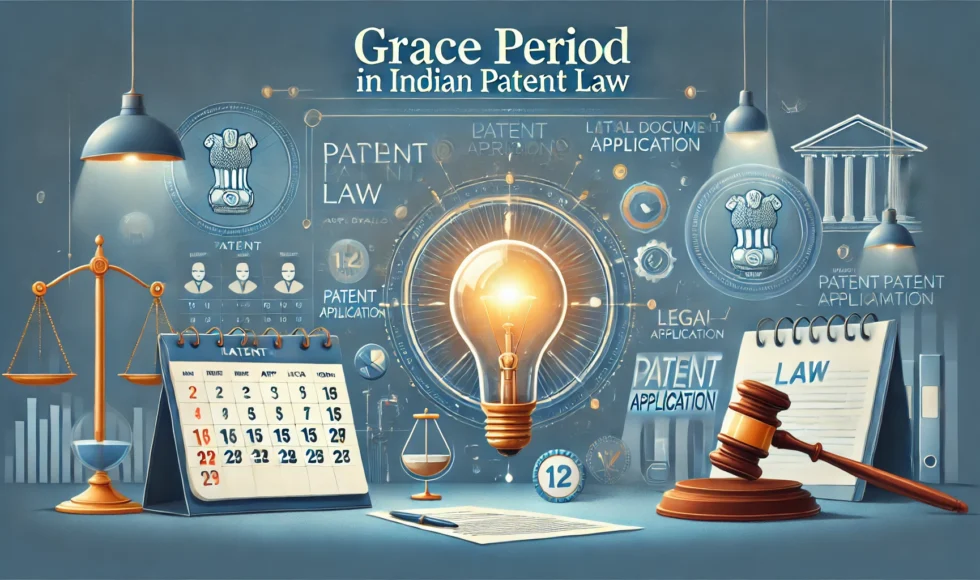Introduction
Sometimes, inventors need to publicly disclose their invention publicly before filing a patent application—whether to present at conferences, seek funding, test the market, or demonstrate innovations to collaborators. Normally, such public disclosure destroys novelty and makes the invention unpatentable.
However, the Indian Patents Act, 1970 recognizes that early disclosure may be unavoidable. To address this issue, Chapter VI (Anticipation) – specifically Section 31 – provide grace period provisions. These provisions create narrow exceptions where certain public disclosures will not be treated as prior art, provided specific conditions are met and the patent application is filed within 12 months of such disclosure. This 12-month “grace period” acts as a safety net, allowing inventors to explore opportunities while still protecting patent rights.
Anticipation and the Role of Grace Period
Anticipation occurs when an invention is already known or used before the patent application’s priority date, thus destroying its novelty. Under Section 13, the Indian Patent Office must search for such anticipatory disclosures.
However, Sections 29–34 of Chapter VI create exceptions—specific scenarios where disclosures will not count as prior art. The most important of these is Section 31, which offers a 12-month grace period for certain types of public disclosures.
The Legal Framework – Chapter VI Overview
Section 29: Anticipation by Previous Publication
Protects applicants against prior publications if:
- The published matter was obtained from the applicant without his consent.
- A patent application was filed by the applicant as soon as reasonably practicable after learning of the publication
- The invention was not commercially worked in India before the priority date, except for reasonable trial purposes.
This section also provides that if a person other than the true and first inventor files a patent application in contravention of the inventor’s rights, the said application will not anticipate the inventor’s application.
Section 30: Anticipation by Previous Communication to Government
Communicating an invention to the Government (or any person authorized by the Government) to investigate the invention or its merits does not destroy novelty. This provision encourages inventors to cooperate with Government without fearing loss of patent rights.
Section 31: Anticipation by Public Display, etc. (The Core Grace Period Provision)
Section 31 is the primary grace period provision, stating that an invention is not anticipated if the disclosure occurred in one of the following ways, provided the application is filed within 12 months of disclosure:
- Government-notified Exhibition: Display or use of the invention, with the true and first inventor’s consent, at an industrial or other exhibition officially notified by the Central Government in the Official Gazette;
- Publication consequent to such Exhibition: For example, a catalogue or brochure issued during the exhibition.
- Unauthorized Use during Exhibition: Use of the invention by a person without the inventor’s consent after it has been displayed or used and during the exhibition period
- Learned Society Presentations: Description of the invention in a paper read by the true and first inventor before a learned society, or publication with the inventor’s consent in the transactions of such society.
For example, if an inventor presents a new medical device at a DPIIT-notified industrial expo on 10 January 2025, the patent application must be filed by 10 January 2026 to claim the grace period.
Section 32: Anticipation by Public Working
An invention is not anticipated if, within one year before the priority date, it was publicly worked in India by:
- The patentee or applicant or any person deriving title from them, or
- Any other person with their consent,
if the working was for the purpose of reasonable trial only and if it was reasonably necessary that such working be conducted in public considering the nature of the invention.
Section 33: Anticipation by Use and Publication after Provisional Specification
If an invention is used or published after filing a provisional specification, the complete specification shall not be deemed anticipated by such use or publication. For convention applications, this protection applies from the priority date.
Recent Developments: Rule 29A and Form 31 (March 2024)
The Patents (Amendment) Rules, 2024, effective March 15, 2024, introduced Rule 29A and Form 31 to formalize the grace period application process. Rule 29A states: “An application to avail the period specified under section 31 shall be filed in Form 31, along with the fees specified in the First Schedule.”
Form 31 requires:
- Applicant details and application number;
- Selection of applicable provision (Section 31(a), (b), (c), or (d));
- Comprehensive documentary evidence;
- Undertaking that application is filed within 12 months; and
- Proper signatures and attestations.
Evidence Requirements
For Exhibition-Based Claims (Section 31(a), (b) and (c)):
- Proof of Central Government notification of the exhibition.
- Evidence of inventor’s consent for display.
- Documentation of exhibition dates and display details.
- Press reports or publications resulting from exhibition display.
- Documentary proof or affidavits showing use without consent during the exhibition.
For Learned Society Claims (Section 31(d)):
- Evidence of presentation before a learned society.
- Proof that publication was in “transactions” of the society.
- Documentation of inventor’s consent for publication.
- Meeting minutes or society records.
Practical Guidelines for Inventors
Before Disclosure:
- Verify Exhibition Status: Ensure exhibitions are Government-notified.
- Document Everything: Maintain detailed records of dates, consent, and circumstances.
- Limit Disclosure Scope: Only disclose what is absolutely necessary.
- Consider Provisional Filing: File at least a provisional application before disclosure when possible.
After Disclosure:
- Mark Calendar: Note the 12-month deadline from disclosure date.
- Gather Evidence: Collect all required documentation for Form 31.
- Prepare Application: Draft complete specification covering the disclosed invention.
- Submit Form 31 with patent application and prescribed fees.
Why Grace Period should be a Last Resort
The grace period is a safety net, not a strategy. Even with proper documentation, there is risk—particularly if:
- The exhibition was not properly notified.
- The disclosure falls outside the scope of Section 31.
- Evidence is incomplete or challenged.
Best practice: File before disclosure whenever possible.
Frequently Asked Questions (FAQ)
Q1: What is the grace period in Indian patent law?
A1 A 12-month window under Section 31 allowing patent filing after specific public disclosures without losing novelty.
Q2: Which disclosures qualify for grace period?
Display at government-notified exhibitions, resulting publications, unauthorized exhibition use, and learned society presentations.
Q3: Is Form 31 mandatory?
Yes, since March 2024, Form 31 must be filed when claiming Section 31 benefits.
Q4: Can journal publications qualify?
Only if published in “transactions” of a learned society, not general academic journals.
Q5: What evidence is required?
Dates, consent documents, government notifications, publications, and affidavits as applicable.
Q6: Should I file provisional application first?
Yes, this is the safest approach to secure priority before any disclosure.
Q7: What defines a “learned society”?
Non-commercial peer groups promoting knowledge.
Q8: Are there any fees for Form 31?
Yes, prescribed fees must be paid as specified in the First Schedule of Patent Rules.
Q9: Can I claim multiple provisions in one application?
Yes—if you have multiple qualifying disclosures, provide evidence for each in Form 31.
Q10: How to prove unauthorized use under Section 31(c)?
Documentary proof or affidavits showing use without consent during the exhibition.
Conclusion
The grace period provisions in Chapter VI of the Indian Patents Act provide valuable protection for inventors who need to disclose their inventions publicly before filing patent applications. However, these provisions must be understood as narrow exceptions to the general novelty requirement. Section 31 offers the primary grace period of 12 months for specific circumstances including Government-notified exhibitions and learned society presentations.
The introduction of Rule 29A and Form 31 in 2024 has formalized the process, requiring comprehensive documentation and evidence. While these provisions offer important protection, inventors should ideally file patent applications before any public disclosure to avoid potential complications.
Success in claiming grace period benefits depends on careful planning, thorough documentation, and strict compliance with the statutory requirements. Given the technical nature of these provisions and their restrictive interpretation, professional legal advice is strongly recommended for inventors considering public disclosure of their inventions.

